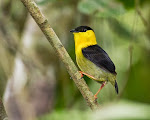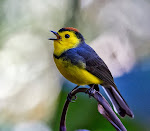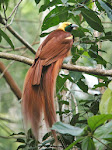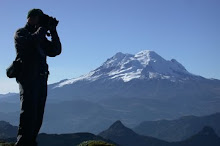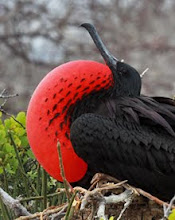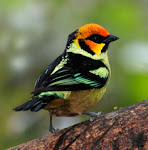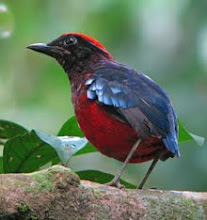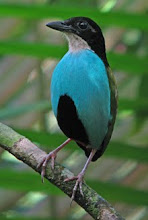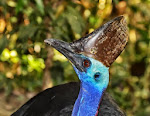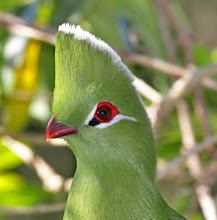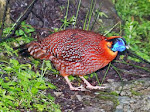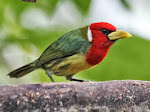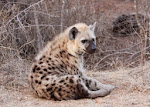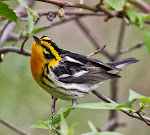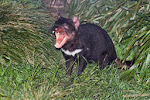Our final day we changed plans and went on the hunt of a hot tip - a roosting Bare-shanked Screech-Owl that was allegedly a "given". As it turned out, this was not the case, and we bumped into a bunch of local guides shaking their heads in disbelief that it was not there that day as it normally was expected to be! Having tried for this also around Savegre on two separate nights, it seemed this was fast becoming my "nemesis' for Costa Rica. However, the area near Monteverde we checked out was far from boring: we found our first Golden-bellied Flycatchers for the tour (and of course lifebirds for me), and also found our only Geoffroy's Spider-Monkeys of the tour and Highland Hepatic Tanager of the tour, which fed low in the open for some time.
Once again, we found yet more White-eared Ground-Sparrow, which were remarkably numerous for us on the tour. However, the bird that caused us to finish on the biggest of highs was a small party of Golden-browed Chlorophonias. Although we had already encountered them twice earlier, this was just one of those, special, low sightings that make you realise the bird is yet better than both you imagined and experienced previously.
Once again, we found yet more White-eared Ground-Sparrow, which were remarkably numerous for us on the tour. However, the bird that caused us to finish on the biggest of highs was a small party of Golden-browed Chlorophonias. Although we had already encountered them twice earlier, this was just one of those, special, low sightings that make you realise the bird is yet better than both you imagined and experienced previously.
And I am sure it was from this star turn that the species made it onto our top five birds of the trip list, at a heady second no less. When you see such a beautifully-coloured bird, so well, it is hard to believe it would not make it to number one in the charts, although with the unmovable Resplendent Quetzal sitting in pole position, it was perhaps understandable on this occasion, why the chlorophonias had to settle for second place! In the final countdown, over a splendid farewell dinner back at the Hotel Bougainvillea, the final top five birds of the tour were decided:
2 GOLDEN-BROWED CHLOROPHONIA
3 SNOWCAP
4=LESSER GROUND-CUCKOO
4=BLACK-AND-WHITE OWL
...And a worthy top five too; it was certainly hard to argue with the choices, when looking back.
My TOUR in Costa Rica (actually Michael's tour) in Costa Rica may have come to a close, but my time in Costa Rica lingered on. Andrew Spencer and his Tayler Brooks were flying in, and we were set to meet again the next day and go in pursuit of yet more photos of Costa Rica's amazing birdlife...




















































